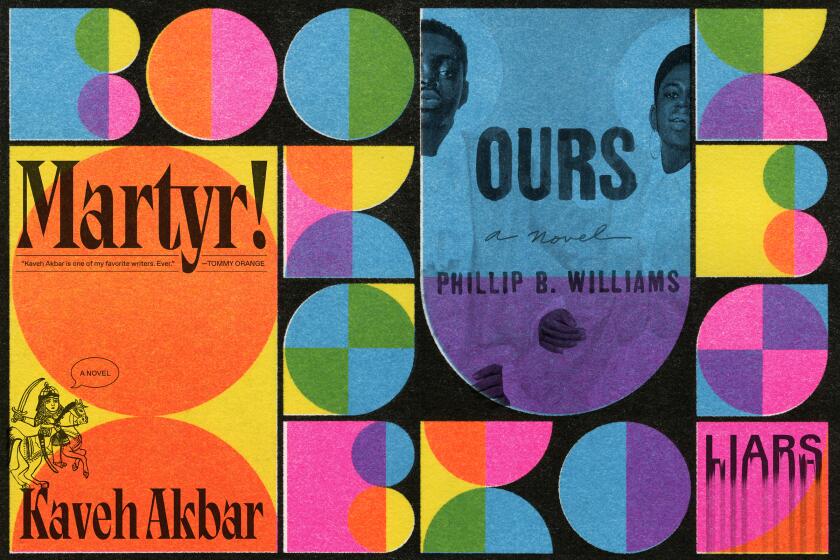Is the Southwest America’s obscure hinterland — or its rightful heartland?

Book Review
American Oasis: Finding the Future in the Cities of the Southwest
By Kyle Paoletta
Pantheon Books: 352 pages, $30
If you buy books linked on our site, The Times may earn a commission from Bookshop.org, whose fees support independent bookstores.
Kyle Paoletta is a native son of Albuquerque, where he grew up longing for something bigger and better. “Space was everywhere, and yet I felt that I was gazing through a gauze of cottonwood seed,” he writes in his new book, “American Oasis.”
He decamped for the bustling environs of Boston and New York, where he eventually grew irritated with the East Coast’s comprehensive ignorance of the Southwest. More than one person asked him what it was like growing up in Arizona or expressed astonishment that it snows in New Mexico.
“American Oasis” is a response of sorts, a lively, thoughtful tour through the history and culture of Phoenix, El Paso, Las Vegas and other cities of the region’s deserts and plains. But it’s also a guide and a warning. With climate change making more of the country feel like the Southwest, Paoletta wants the reader to understand how the region’s people live in unforgivingly arid terrain — because even if you don’t come to the Southwest, the Southwest will soon be coming to you.
We asked three critics to share their favorites of the year, and they served up diverse offerings heavily weighted toward fiction.
The portraits that emerge both enhance and poke holes in the stories the Southwest tells itself — tales of can-do individualism, defiance of expectation and rebirth. (It’s no accident that Phoenix is called Phoenix.)
Native Americans were there first, of course; Mexicans, Spaniards and eventually white Americans waged battles and forged alliances with them and each other. “The growth of the white population has been slow,” the writer William Smythe noted of New Mexico in 1900, “but will increase rapidly with the development of irrigation.” To which Paoletta wryly adds: “Evidently, land — when watered — would sprout white people.”
The racism of many early boosters of the Southwest was scarcely masked; there was a whole lot of saying the quiet parts out loud. In 1920, Phoenix’s Chamber of Commerce exalted “a modern town of forty thousand people and the best kind of people, too. A very small percentage of Mexicans, negroes or foreigners.”
Looking forward to some of our most anticipated books hitting store shelves in 2025 — including one about literary icon Joan Didion — and reflecting on last year’s crop of releases.
Paoletta frames much of the growth of the Arizona city — now the fifth-largest in the United States — through the lens of the magazine Arizona Highways. With its eye-popping landscape photo spreads, the publication drew the attention of readers far outside the city and state. Self-promotion was woven into the city’s fabric from the start, Paoletta writes: “For all the astounding things Phoenix has achieved in the 150 years since its founding, the city’s culture has remained rooted in an earnest and unwavering belief in its ability to forge a vision of paradise out of whole cloth.”
Water is a key element in the development of the Southwest as well as the early chapters of “American Oasis.” Some of the book’s treatment of dams, rivers, basins and irrigation is a little … dry. But the action soon picks up as Paoletta places a series of big characters and personalities within the context of their surroundings.

The chapter on Las Vegas is itself a small masterpiece that should be read by anyone seeking to understand a city that seems to defy comprehension. Paoletta covers the early years, marked by shady characters such as the mobster Bugsy Siegel and the “If you build it, they will come” ethos that defines so much of the Southwest. Then he digs into the city’s struggles to desegregate and its hard-won victories for labor rights: “Las Vegas has become one of the few cities in America where service work is a sustainable career, one that can provide a home, health insurance, and a comfortable life.”
And he wanders the city in search of stories, which he renders in exquisite detail. Here he is navigating the sensory overload of downtown Las Vegas’ Fremont Street Experience: “I got moving again once the stench of weed had gotten too overpowering and walked for a minute behind a burly dude in a T-shirt that read ‘Pipefitters Local 57 — Boston, MA,’ a backward Patriots hat on his head. The Dancing DJ flipped the soundtrack to Shakira, and suddenly the canopy was all tropical and coral.” Thanks to Paoletta’s gimlet eye, what happens in Vegas doesn’t stay in Vegas.

“American Oasis” is the work of an insider who became an outsider and gradually found his way back in. These combined perspectives give Paoletta a sort of passionate objectivity; we feel him reconsidering his subject as we turn the pages.
“There is no high culture or low culture in the Southwest — just culture,” he writes. “Those who ignore the region or refuse to acknowledge its status as quintessentially American do so out of a misplaced belief that social position or intellect can somehow elevate you above the rude reality of capitalism.”
In this sense, the Southwest just might be the epitome of American democracy, a place where the country looks to reestablish ideals that are in increasing jeopardy.
Chris Vognar is a freelance culture writer.
More to Read
A cure for the common opinion
Get thought-provoking perspectives with our weekly newsletter.
You may occasionally receive promotional content from the Los Angeles Times.












